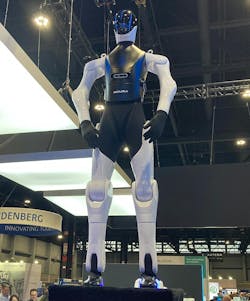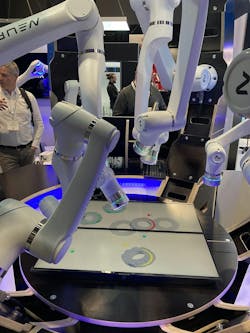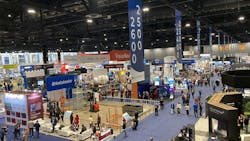Remote monitoring, health and safety lead robotics applications in maintenance
Jeff Burnstein is president of the Association for Advancing Automation (A3), a trade group representing more than 1,000 global companies involved in associations focused on robotics, machine vision, motion control, and motors and related technologies. He has been actively promoting the use of robotics, machine vision, AI, and motion control for more than 40 years, including giving testimony before a Congressional committee examining robotics as a disruptive technology.
Jeff sat down with Plant Services chief editor Thomas Wilk at this year's Automate Show in Chicago to talk about the ways that robotics and automation are finding increased application in the machine health and condition monitoring space, and why humanoid robots are the next automation frontier.
PS: What are some of the trends you're seeing in automation in 2024?
JB: One of the first trends I see here at Automate is the number of collaborative robot companies there are, and all the new applications for collaborative robots, things that in the beginning you wouldn’t have thought about: welding, painting, assembly, of course, but heavier payload collaborative robots. That's the first thing that jumped out at me as I walked the floor this morning, so I think we'll be seeing a lot of that going forward.
PS: A lot of Plant Services readers are focused on the machine health space and also the supply chain space. How have you seen automation changing supply chain, warehousing, logistics, things like that?
JB: The major transformation in those spaces due to automation and robotics, certainly with autonomous mobile robots (AMRs) in warehouses and factories With the advent of artificial intelligence to help make the robots smarter when they're picking up boxes and packaging things, I think we're going to continue to see the warehousing space be an important one, but also the use of those technologies is on the rise in manufacturing.
PS: Do you see automation equally enabling small to medium sized businesses as larger businesses these days?
JB: We've done some looking into that, and it seems like there's a lot more interest small and medium sized companies than ever before in automating. Technology is getting less expensive, easier to use, and I think you're going to see that trend continue where small and medium sized companies are finding ways to take advantage of these technologies.
PS: In the asset management / machine health sector, it's difficult for new reliability engineers to be minted quickly enough to fill demand. One of the things I've noticed is that the more that you can automate simple tasks, the less these engineers will have to do them as part of their daily job, and the more they can focus on what they're really trying to do.
JB: That's a really important insight, because when you think about what robots are meant to do, it’s to augment people. People are really good at a lot of things that aren't just lifting heavy materials or walking back and forth all day. So if you've got skilled engineers that can take advantage of using the robots to do the things that are dull, dirty, dangerous, and repetitive, then that's a big advance.
PS: One of the truisms of reliability is that a reliable plant is a safe plant, and robots are changing the way people stay healthier on their job with fewer injuries.
JB: Repetitive motion, heavy lifting, all of those things that workers would traditionally go home at the end of the day and have a sore back, with a lot of missed time because of those types of things. Now, with automation doing that, they have people available more frequently to be at work and use their minds. And (at his morning keynote at Automate) Billy Beane was spot on with that: availability and the ability to stay healthy is what often differentiates winning teams from ones who aren't as successful.
PS: When it comes to condition monitoring data collection, a lot of times I've seen plant teams deploy robots, like Boston Dynamics’ Spot, to carry either sensors or cameras into places where humans can't go. What kind of trends or innovations have you seen in this space to help collect machine health data and bring it back up to the cloud and help remote-monitor dirty dangerous places?
JB: I think remote monitoring is a key application area, and Boston Dynamics and others who can get the robot into places that you wouldn't want to put a person or couldn't put a person, I think that's a big advance. I think that's a step forward and I think we'll see more of that.
PS: Looking forward to 2025, what do you see happening in this space this year and beyond?
JB: One of the. Things that we're looking at now is a lot of interesting humanoid robots and a lot of money being invested. We've got at least one humanoid robot on the floor here at Automate this year. We're doing a humanoid robot forum in Memphis in October, and by 2025 I wouldn't be surprised to see several more humanoid companies in the space, and hopefully at Automate.
PS: That surprises me a little, because human robots are so much more difficult to develop than your classic AGVs or AMRs.
JB: If you look at companies like Agility Robotics and Apptronik, they're making progress and they're already being used in pilot programs at automotive companies and other spaces. If those are successful, you can anticipate with all the labor shortages out there and you think about the workspace designed for a human, there could be a bigger market than we all may have expected. I'll admit, I'm on the skeptical side of how fast it will happen, but I do believe it will happen, and especially with a lot of money flowing into this space, so we'll see.





